Key Insights
- In Q4’22, Livepeer saw increased demand from apps and developers. The core team’s focus on supporting Web3 video app development materialized into network usage reaching an all-time high of ~42 million minutes of transcoded video.
- As a result of increased usage, demand-side revenue in ETH reached an all-time high, up 45% QoQ and 131% YoY. In USD terms, demand-side revenue increased 27% QoQ but declined 25% YoY due to the overall market downturn.
- Revenue from staking rewards decreased 17% QoQ in LPT (down 21% in USD terms). While LPT staking rewards grew 22% YoY, they decreased 77% YoY in USD.
- Despite the rewards declining in USD terms YoY due to the market downturn, Livepeer’s supply-side participants remained committed to providing transcoding services.
- As of Q4’22, Livepeer offers a streaming layer on top of decentralized storage. Looking back on 2022, Livepeer has come a long way, cementing itself as a prominent Web3 infrastructure provider for developers integrating video streaming into Web3 apps.
Primer on Livepeer
Building decentralized video apps like Twitch or TikTok requires heavy infrastructure for video streaming. Based on a user’s bandwidth and device, video content needs to be processed — i.e., transcoded — into viewable formats. While cloud providers like AWS, Google, or Microsoft are commonplace solutions for video transcoding services, they incur high costs.
Livepeer offers an open and permissionless transcoding marketplace — allowing anyone to contribute compute resources and to compete on price. The network is designed to reduce transcoding costs for end users by up to 10x.
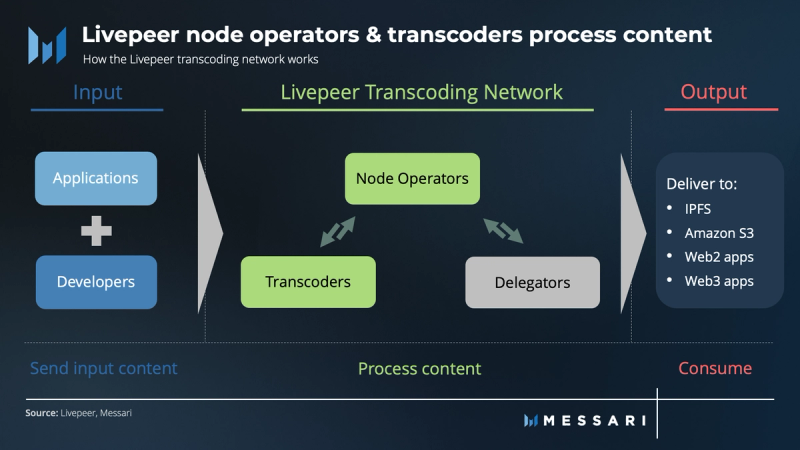
Within Livepeer’s decentralized transcoding network, there are three key participants:
- Node operators — called “orchestrators” — route transcoding jobs. The amount of work a node operator can perform is proportional to how many Livepeer native tokens (LPT) it stakes. Node operators earn ETH fees and newly minted LPT rewards.
- Transcoders provide compute resources for node operators and deliver transcoded video content. In return, they earn ETH fees.
- Delegators stake LPT towards effective node operators to help secure the Livepeer network. Staking is rewarded with a portion of both ETH fees and newly minted LPT rewards.
Beyond transcoding, as of Q4’22, Livepeer offers a customizeable streaming layer on top of decentralized storage networks, e.g., IPFS and Arweave. Simultaneously, Livepeer aims to become the go-to decentralized technology stack for developers integrating video streaming into their apps.
Key Metrics

Performance Analysis
Financial and Network Overview
Demand for Livepeer services comes from apps and developers in need of video transcoding and live streaming services. For example, decentralized social media (DeSoc) apps like TikTok or Twitch or music streaming apps like Spotify or SoundCloud require streaming infrastructure to broadcast content.
Network Usage at All-Time High
Livepeer’s network usage can be gauged by the number of minutes of video transcoded.

Q4’22 saw a record of more than 42 million minutes of video transcoded on the Livepeer network — a 16% increase from Q3’22. On a year-over-year basis, the increase was 44% from nearly 30 million minutes transcoded in Q4’21.
This increase demonstrates a healthy demand for Livepeer video transcoding services. As of Q4’22, more than 90% of network usage continues to come through Livepeer Studio’s broadcasting service (facilitating the delivery of transcoded results to end users) and is reportedly broken down as follows:
- Social apps (36%)
- Music streaming apps (40%)
- Other (24%)
Livepeer Studio is developing tools that plug into the transcoding network and make it easier for developers to integrate video streaming directly into the apps they build. As a result, developers are expected to increasingly use these tools to broadcast video to end users as opposed to leveraging Livepeer Studio’s broadcasting services.
Demand for Livepeer services is expected to continue growing as new Web3-enabled streaming apps break out of the prototype phase. Furthermore, optimized tooling is expected to drive further demand from existing apps and developers, as discussed in the Ecosystem and Development Overview.
Network Revenue
Livepeer’s network revenue consists of demand-side and supply-side revenue.
Demand-side revenue comprises ETH fees accrued from transcoding services. Node operators with larger amounts of stake are more likely to receive more transcoding work, which, in turn, results in them earning more transcoding fees.
Supply-side revenue consists of revenue from:
- LPT staking rewards (accrued by node operators and delegators), which yields inflationary issuance of the token.
- ETH fees for transcoding services (accrued by node operators and transcoders).
The latter doesn’t include ETH fees distributed to delegators, since delegators don’t actively participate in the supply of transcoding services.
Demand-Side Revenue from Transcoding
Fees from transcoding services are paid to node operators in ETH and are further distributed to transcoders and delegators.

Livepeer transcoding fee revenue reached an all-time high in ETH terms in Q4’22, up 45% relative to the previous quarter. On a year-over-year basis, it increased 131%, relative to Q4’21.
In USD terms, Livepeer transcoding fee revenue increased 27% to over $116,000; however, on a year-over-year basis, it declined 25% due to the ETH price depreciation relative to USD in the context of the overall market downturn.

The spikes in the daily cost per minute transcoded correspond to lower daily demand for transcoding (gauged in terms of daily minutes transcoded). Overall, the average cost per minute transcoded stayed low since the Arbitrum migration in February 2022 — i.e., it remained slightly below $0.003 in Q3’22 and Q4’22, down from almost $0.004 in Q2’22. The resulting average price per hour in Q4’22 was $0.18, which is a +10x improvement from the costs charged by cloud services such as Amazon — around $2.25 per stream per hour for live encoding and packaging.
The revenue from transcoding fees is relatively insignificant compared to the revenue from staking rewards (as discussed in the section below). Like other Web3 infrastructure protocols, Livepeer incentivizes its node operators with inflationary rewards. This subsidization enables Livepeer to compete with existing transcoding providers like Amazon and Google.
As fees per minute transcoded are expected to decline with an increasing operator limit (presently set to 100 node operators), the number of transcoded minutes needs to continue growing for the Livepeer protocol to be sustainable. As discussed in the Development Beyond Transcoding section, Livepeer is well-positioned in a market with significant upside potential for two reasons:
- Streaming layer: Livepeer now offers a streaming layer on top of decentralized storage.
- Infrastructure provider: Livepeer aims to build the go-to decentralized technology stack for developers integrating video streaming into their apps.
Staking Reward Revenue
The Livepeer network distributes staking rewards in LPT to node operators and delegators. To provide transcoding services on the Livepeer network, node operators must stake LPT. A node operator’s stake weight comprises their own tokens and those delegated towards them.

Staking reward revenue in LPT terms decreased 17% to over 538,000 LPT in Q4’22. On a year-over-year basis, this translates to a 22% increase from over 441,000 LPT in Q4’21. In USD terms, revenue from staking rewards was down 21% to $3.8 million.
While this is a far cry from the all-time record of $16.9 million in Q4’21 (77% decrease year-over-year), it’s also a testimony to the resilience of the Livepeer network. Despite the overall market downturn, Livepeer’s supply-side participants remain committed to providing transcoding services despite declining rewards in USD terms. As of Q4’22, the vast majority of revenue continues to come from staking rewards.
As killer social apps are built, it remains to be seen to what extent Livepeer network participants will capture value out of increased usage and new use cases for video processing. One way for node operators to capture value from transcoding is by having larger stakes on the network to increase the likelihood of receiving more transcoding work, and in turn, receive a greater share of fee revenue.
Staking Overview
The LPT token follows the Stake-for-Access (SFA) model, also known as a work token model. That is, Livepeer requires its node operators to stake the native token (LPT) to perform work on the network. Node operators’ stake comprises their own LPT tokens (i.e., self stake) and LPT delegated towards them (i.e., delegated stake).
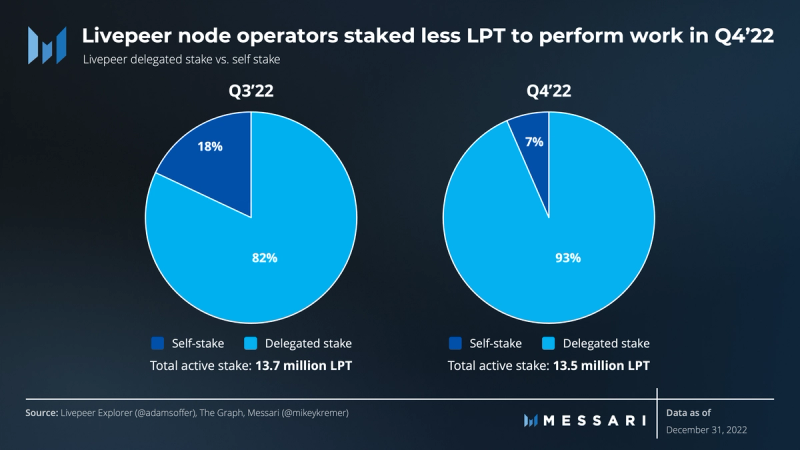
As per the end of Q4’22, nearly 13.5 million LPT (out of the total supply of 27 million LPT) has been staked by the 100 node operators and the nearly 4,250 delegators on the Livepeer network. Delegated stake in Q4’22 was 12.6 million LPT, representing 93% of the total active stake (up from 82% in Q3’22); node operators’ self stake represented the remaining 7% (nearly 900,000 LPT).
Our Q3’22 quarterly report found that the Livepeer network participation rate — the percentage of the circulating LPT supply that is staked — remained around the 50% equilibrium threshold since Q4’21, with an overshoot to 53% throughout Q3’22. In Q4’22, the Livepeer network participation rate drew back to the 50% equilibrium threshold.
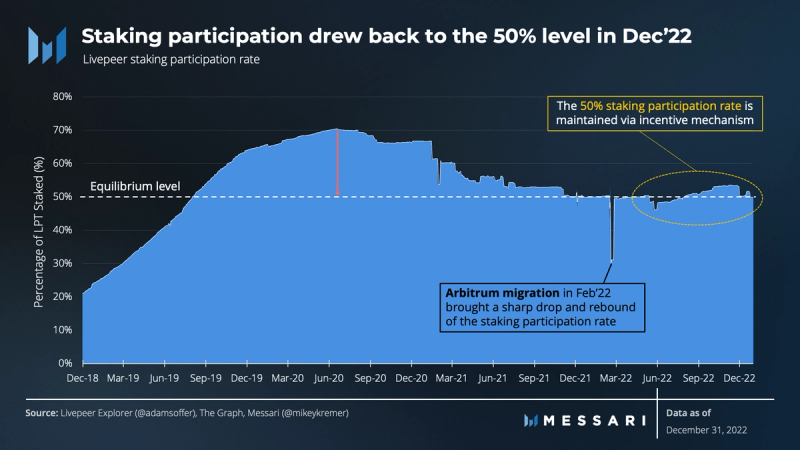
The fluctuations of the staking participation rate should not be regarded as an anomaly but as a feature. Livepeer ensures that participation stays balanced around the predetermined target rate of 50% by dynamically issuing LPT staking rewards. This incentive mechanism works as follows:
- When the participation rate falls below 50% in a given round, LPT issuance increases by 0.00005%.
- Conversely, when the participation rate passes 50%, inflationary issuance decreases by 0.00005%.
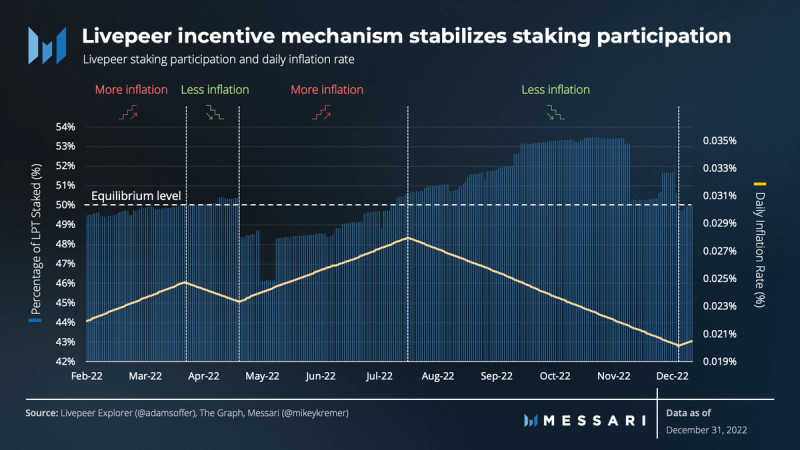
In September 2022, the participation rate overshot to 53%; however, by the end of December 2022, it returned to the target equilibrium level of 50% thanks to the gradual decrease in LPT token inflation. In other words, the gradual increase in the participation rate to 53% throughout Q3’22 and Q4’22 led to a gradual decrease in LPT issuance from 0.028% to below 0.020%.
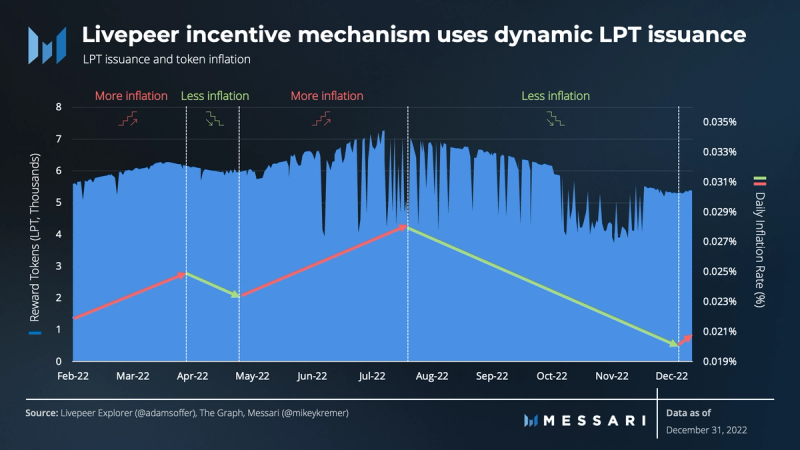
The dynamic LPT issuance in absolute terms mirrors the pattern of successive increases and decreases in token inflation. The fluctuation in staking participation around the 50% equilibrium level is expected to continue as a result of the dynamic staking inflation mechanism.
Ecosystem and Development Overview
Latest Release
As of Q4’22, Livepeer supports video files of up to 10GB in size, a 10x increase from the previous limit of 1GB. This upgrade allows users to stream 8-10 hours of high-definition transcoded video per file. Additionally, the release supports multiple concurrent uploads and all common file types, not only MP4. Users can now upload videos with more flexibility and from multiple device types.
Development Beyond Transcoding
Livepeer is committed to driving greater video volumes through the Livepeer transcoding network. The focus of the core team is twofold:
- To support developers of Livepeer-enabled apps and integrations.
- To enhance the Livepeer protocol with Web3-native features.
Video on Demand Streaming
Livepeer’s recent release includes a brand-new capability: video on demand (VOD) streaming. Prior to this, developers needed to either leverage centralized solutions or develop their own custom solutions to deliver transcoded streams from the Livepeer network to end users. The release expands Livepeer’s offering to include an open-source, Web3-enabled video player.
The video player streams video files that are stored on decentralized storage protocols like IPFS and Arweave. It can be embedded anywhere and uses a broadcasting provider (Livepeer Studio or otherwise) to transcode video files pulled from storage. In case of transcoding latency, the video file will play directly from storage until the optimized transcoded result from Livepeer is available. This provides redundancy to the stream and allows a user to continue watching — albeit at a possibly decreased quality — should the transcoded video be delayed. The web player also has other Web3-native features like a built-in token-gating mechanism.
Livepeer has thus expanded to offer a streaming layer on top of decentralized storage networks; transcoding and caching video, and delivering optimized video playback to a global audience. So far, the reported success rate of the player has been high — imports from IPFS range from a 95-98% success rate — and improvements for global coverage are underway in Africa, South America, and India.
Livepeer continues to position itself as more than just a transcoding network by “creating a decentralized technology video streaming stack that plugs into the other Web3 components.” Developers can now mix-and-match the use of open-source tools developed by Livepeer and the community, as well as services offered by broadcasters like Livepeer Studio, to curate decentralized Web3 video experiences.
As a first mover of the video player, the StonerCats NFT video series from Mila Kunis and Ashton Kutcher is using Lit and Livepeer to create a “perpetual token-gated video streaming app for NFT token holders.” While it previously used centrally hosted Web2 streaming infrastructure, the video series is now a token-gated app hosted inside Arweave and powered by Livepeer video transcoding and streaming.
Long Take NFTs
When Livepeer started to expand its offerings beyond transcoding back in Q2’22, minting video NFTs was one of the first tools offered. As an extension of this, Livepeer released the Long Take NFTs app in Q4’22 which allows users to create NFTs using up to 10GB file sizes. This stands out compared to popular NFT marketplaces with significantly lower file size limits like OpenSea with 100MB.
Long Take NFTs are stored on IPFS and can still be uploaded to marketplaces like OpenSea despite the larger file size creation limit. They accept input from a number of video and audio formats ranging from MP4 to WMV and can handle up to 2k resolution with unrestricted aspect ratio, meaning that the shape of the NFT isn’t limited to an even square. These features allow NFTs to represent a variety of high-quality long-form content, like music videos or feature films. In addition, device-specific playback settings are leveraged upon viewing as videos are transcoded through Livepeer.
Grants and Hackathons
The Livepeer core team continued to attend and contribute to nearly every major hackathon in Q4’22, including ETHBogota, ETHBerlin, and Superfluid’s Wave Pool. Livepeer also partnered with Encode for the “Next Video Build,” an 8-week Livepeer-specific hackathon from November to January. Prizes delivered to hack participants included an audio media player (Audio.xyz), a livestreaming and betting platform (Bet Streams), and a billboard platform for the metaverse (Relmia).
Notable grants from Livepeer’s $250,000 per quarter grants program included three allotments to streaming apps Lenstube, DeCommune, and Maven, as well as exploratory work on integrating copyright protection into the network with Near Duplicate Video Detection / Video Based Fraud Detection.
Qualitative Analysis
Livepeer Ecosystem: Notable Events
Introduced StreamETH
Two significant Q4 events for Livepeer were ETHBogota and Devcon in October 2022. Built in collaboration with the Ethereum Foundation, Devcon was streamed using StreamETH, a public good project for video live streams and playback. About 60,000 people in total watched live streams of the event, 40% of which watched through the StreamETH player instead of Youtube – though the YouTube stream was also transcoded via Livepeer.
Hosted the Web3 App Summit
Livepeer hosted an event for builders of the Web3 stack to discuss “the path to full Web3 adoption” and the killer Web3 social apps that will contribute. The keynote panel discussed Web3 social’s role in enabling users to monetize and trade the social capital that each individual inherently has, which is presently trapped on Web2 systems. The panel was moderated by David Hoffman from Bankless, with speakers Stani Kulechov from Aave and Lens, and Evin McMullen from Disco.
Livepeer founder Doug Petkanics provided additional depth to his thesis on the killer Web3 social apps. He notes that they will not be clones of traditional social media platforms like YouTube alone; instead, these apps will introduce new tools and primitives for the Web3 world. To this end, developers can start by identifying problems in Web3 and building tools around them.
Integrated with Aptos
While the Livepeer operator network functions on Arbitrum, Livepeer transcoded video and streaming tools can be chain-agnostic. While Livepeer development tools were initially designed to enable Web3 features on EVM-compatible chains, as of December 2022, the Livepeer docs offer tools that enable Livepeer-transcoded video with Web3 features on Aptos, including minting video NFTs.
Up and Coming: Livepeer-Enabled Apps
There is a series of apps enabled by Livepeer that are starting to gain attention, including:
- Xeenon – Streaming app on Arbitrum.
- Beem – Web3 video streaming platform for filmmakers.
- Onboard – Lens protocol frontend on Android and IoS.
- Bonfire – Community engagement platform designed for Web3 creators with social tokens and NFTs that offers no-code live streaming and VOD capabilities.
- Lenstube – YouTube-esque protocol using the Lens social graph and Livepeer and Arweave for storing and transcoding video and playback. Users can tip creators and collect videos as NFTs, and creators can design token-gated memberships.
Roadmap
The Livepeer roadmap is focused on integrating the Livepeer transcoding network further with the Web3 world. Over the last year, we have seen noteworthy progress from the Livepeer core team and community when it comes to building tools that make leveraging the network easier. Moreover, apps that got their start in Livepeer-hosted hackathons and grants are beginning to emerge from the production phase.
By embedding with and supporting the Web3 community, Livepeer is focused on developing the tooling and apps that ultimately drive demand to the network. While there are numerous projects in production, several noteworthy initiatives include optimizations to the VOD player:
- An encryption mechanism such that developers embedding the video player can specify access control logic for video files stored on IPFS.
- Optimized short-form video capabilities that provide users with a seamless swiping experience when using DeSoc apps.
Closing Summary
In Q4’22, Livepeer saw increased demand from apps and developers. The project’s focus on supporting Web3 social app development materialized into network usage reaching an all-time high of ~42 million minutes of transcoded video. As a result of increased usage, demand-side revenue in ETH also peaked, jumping up 45% QoQ and 131% YoY. In USD terms, demand-side revenue increased 27% QoQ but declined 25% YoY. Staking rewards decreased 17% in LPT QoQ but increased 22% YoY. In USD terms, this translates to a 21% decrease QoQ and a 77% decrease YoY. Despite this, the participation rate remained consistent around the 50% equilibrium level, a testament to the resilience of the Livepeer network despite the general market downturn.
With Livepeer-enabled tools, it’s getting increasingly easier to build decentralized apps with video streaming features. As of Q4’22, Livepeer offers a robust decentralized transcoding network, a streaming layer on top of decentralized storage, and continues to build open-source tools for developers integrating video into their apps. Looking back on 2022, Livepeer has come a long way, cementing itself as a prominent Web3 infrastructure player through consistently delivering new pieces of the decentralized video stack.















